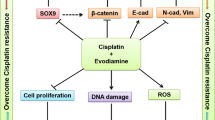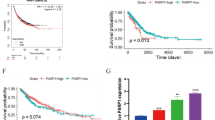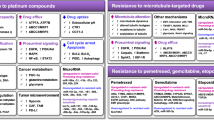Abstract
Purpose
This study was to investigate whether the topoisomerase (Top) I inhibitor topotecan and the Top II inhibitor etoposide could modulate the hypoxia-induced HIF-1α expression in non-small cell lung cancer (NSCLC) cell lines.
Methods
Hypoxic conditions were maintained in a humidified airtight anaerobic incubator flushed with a mixture of gas consisting of 1% O2, 5% CO2 and 94% N2. The expressions of HIF-1α and Akt phosphorylation were measured by Western blotting or quantitative reverse transcription-polymerase chain reaction. Small interfering RNA treatment was done to inhibit the expressions of Top I and IIα. Constitutively active akt was expressed by transient transfection using pUSEamp(+)/myr Akt.
Results
The HIF-1α was increased and this peaked at 9 h in hypoxic conditions. Both topotecan and etoposide in a dose- and time-dependent manner inhibited the accumulation of hypoxia-induced HIF-1α protein. Interestingly, the daily addition of these drugs at a lower concentration could inhibit the HIF-1α expression more effectively than a single treatment, which shows that their effects are schedule-dependent. This down-regulation of HIF-1α was associated with proteosomal degradation and decreased Akt phosphorylation. Top I and Top IIα were required for the inhibitory effect of topotecan and etoposide, respectively.
Conclusion
Both Top I and II inhibitors could suppress the HIF-1α expression in a schedule-dependent manner, and this suggests that these drugs might be useful to overcome the therapeutic resistance induced by tumor hypoxia in NSCLC.





Similar content being viewed by others
References
Beppu K, Nakamura K, Linehan WM, Rapisarda A, Thiele CJ (2005) Topotecan blocks hypoxia-inducible factor-1alpha and vascular endothelial growth factor expression induced by insulin-like growth factor-I in neuroblastoma cells. Cancer Res 265:4775–4781. doi:10.1158/0008-5472.CAN-04-3332
Chapman JD, Engelhardt EL, Stobbe CC, Schneider RF, Hanks GE (1998) Measuring hypoxia and predicting tumor radioresistance with nuclear medicine assays. Radiother Oncol 46:229–237. doi:10.1016/S0167-8140(97)00186-2
Creighton-Gutteridge M, Cardellina JH 2nd, Stephen AG, Rapisarda A, Uranchimeg B, Hite K, Denny WA, Shoemaker RH, Melillo G (2007) Cell type-specific, topoisomerase II-dependent inhibition of hypoxia-inducible factor-1alpha protein accumulation by NSC 644221. Clin Cancer Res 13:1010–1018. doi:10.1158/1078-0432.CCR-06-2301
Harris AL (2002) Hypoxia—a key regulatory factor in tumour growth. Nat Rev Cancer 2:38–47. doi:10.1038/nrc704
Hiraga T, Kizaka-Kondoh S, Hirota K, Hiraoka M, Yoneda T (2007) Hypoxia and hypoxia-inducible factor-1 expression enhance osteolytic bone metastases of breast cancer. Cancer Res 67:4157–4163. doi:10.1158/0008-5472.CAN-06-2355
Hockel M, Schlenger K, Hockel S, Vaupel P (1999) Hypoxic cervical cancers with low apoptotic index are highly aggressive. Cancer Res 59:4525–4528
Hudson CC, Liu M, Chiang GG, Otterness DM, Loomis DC, Kaper F, Giaccia AJ, Abraham RT (2002) Regulation of hypoxia-inducible factor 1alpha expression and function by the mammalian target of rapamycin. Mol Cell Biol 22:7004–7014. doi:10.1128/MCB.22.20.7004-7014.2002
Hur E, Kim HH, Choi SM, Kim JH, Yim S, Kwon HJ, Choi Y, Kim DK, Lee MO, Park H (2002) Reduction of hypoxia-induced transcription through the repression of hypoxia-inducible factor-1alpha/aryl hydrocarbon receptor nuclear translocator DNA binding by the 90-kDa heat-shock protein inhibitor radicicol. Mol Pharmacol 62:975–982. doi:10.1124/mol.62.5.975
Jiang BH, Jiang G, Zheng JZ, Lu Z, Hunter T, Vogt PK (2001) Phosphatidylinositol 3-kinase signaling controls levels of hypoxia-inducible factor 1. Cell Growth Differ 12:363–369
Kunz M, Ibrahim SM (2003) Molecular responses to hypoxia in tumor cells. Mol Cancer 2:23. doi:10.1186/1476-4598-2-23
Liao D, Corle C, Seagroves TN, Johnson RS (2007) Hypoxia-inducible factor-1alpha is a key regulator of metastasis in a transgenic model of cancer initiation and progression. Cancer Res 67:563–572. doi:10.1158/0008-5472.CAN-06-2701
Lu Y, Liang K, Li X, Fan Z (2007) Responses of cancer cells with wild-type or tyrosine kinase domain-mutated epidermal growth factor receptor (EGFR) to EGFR-targeted therapy are linked to downregulation of hypoxia-inducible factor-1alpha. Mol Cancer 6:63. doi:10.1186/1476-4598-6-63
Mabjeesh NJ, Post DE, Willard MT, Kaur B, Van Meir EG, Simons JW, Zhong H (2002) Geldanamycin induces degradation of hypoxia-inducible factor 1alpha protein via the proteosome pathway in prostate cancer cells. Cancer Res 62:2478–2482
Maxwell PH, Wiesener MS, Chang GW, Clifford SC, Vaux EC, Cockman ME, Wykoff CC, Pugh CW, Maher ER, Ratcliffe PJ (1999) The tumour suppressor protein VHL targets hypoxia-inducible factors for oxygen-dependent proteolysis. Nature 399:271–275. doi:10.1038/20459
Minet E, Arnould T, Michel G, Roland I, Mottet D, Raes M, Remacle J, Michiels C (2000) ERK activation upon hypoxia: involvement in HIF-1 activation. FEBS Lett 468:53–58. doi:10.1016/S0014-5793(00)01181-9
Minet E, Michel G, Mottet D, Raes M, Michiels C (2001) Transduction pathways involved in hypoxia-inducible factor-1 phosphorylation and activation. Free Radic Biol Med 31:847–855. doi:10.1016/S0891-5849(01)00657-8
Osada M, Imaoka S, Funae Y (2004) Apigenin suppresses the expression of VEGF, an important factor for angiogenesis, in endothelial cells via degradation of HIF-1alpha protein. FEBS Lett 575:59–63. doi:10.1016/j.febslet.2004.08.036
Rapisarda A, Melillo G (2007) UVC inhibits HIF-1alpha protein translation by a DNA damage- and topoisomerase I-independent pathway. Oncogene 26:6875–6884. doi:10.1038/sj.onc.1210489
Rapisarda A, Uranchimeg B, Scudiero DA, Selby M, Sausville EA, Shoemaker RH, Melillo G (2002) Identification of small molecule inhibitors of hypoxia-inducible factor 1 transcriptional activation pathway. Cancer Res 62:4316–4324
Rapisarda A, Uranchimeg B, Sordet O, Pommier Y, Shoemaker RH, Melillo G (2004a) Topoisomerase I-mediated inhibition of hypoxia-inducible factor 1: mechanism and therapeutic implications. Cancer Res 64:1475–1482. doi:10.1158/0008-5472.CAN-03-3139
Rapisarda A, Zalek J, Hollingshead M, Braunschweig T, Uranchimeg B, Bonomi CA, Borgel SD, Carter JP, Hewitt SM, Shoemaker RH, Melillo G (2004b) Schedule-dependent inhibition of hypoxia-inducible factor-1alpha protein accumulation, angiogenesis, and tumor growth by topotecan in U251-HRE glioblastoma xenografts. Cancer Res 64:6845–6848. doi:10.1158/0008-5472.CAN-04-2116
Richard DE, Berra E, Gothie E, Roux D, Pouyssegur J (1999) p42/p44 mitogen-activated protein kinases phosphorylate hypoxia-inducible factor 1alpha (HIF-1alpha) and enhance the transcriptional activity of HIF-1. J Biol Chem 274:32631–32637. doi:10.1074/jbc.274.46.32631
Ricker JL, Chen Z, Yang XP, Pribluda VS, Swartz GM, Van Waes C (2004) 2-Methoxyestradiol inhibits hypoxia-inducible factor 1alpha, tumor growth, and angiogenesis and augments paclitaxel efficacy in head and neck squamous cell carcinoma. Clin Cancer Res 10:8665–8673. doi:10.1158/1078-0432.CCR-04-1393
Salceda S, Caro J (1997) Hypoxia-inducible factor 1alpha (HIF-1alpha) protein is rapidly degraded by the ubiquitin-proteasome system under normoxic conditions. Its stabilization by hypoxia depends on redox-induced changes. J Biol Chem 272:22642–22647. doi:10.1074/jbc.272.36.22642
Spiro SG, Silvestri GA (2005) One hundred years of lung cancer. Am J Respir Crit Care Med 172:523–529. doi:10.1164/rccm.200504-531OE
Stoeltzing O, McCarty MF, Wey JS, Fan F, Liu W, Belcheva A, Bucana CD, Semenza GL, Ellis LM (2004) Role of hypoxia-inducible factor 1alpha in gastric cancer cell growth, angiogenesis, and vessel maturation. J Natl Cancer Inst 96:946–956
Wan X, Shen N, Mendoza A, Khanna C, Helman LJ (2006) CCI-779 inhibits rhabdomyosarcoma xenograft growth by an antiangiogenic mechanism linked to the targeting of mTOR/Hif-1alpha/VEGF signaling. Neoplasia 8:394–401. doi:10.1593/neo.05820
Wang GL, Semenza GL (1995) Purification and characterization of hypoxia-inducible factor 1. J Biol Chem 270:1230–1237. doi:10.1074/jbc.270.3.1230
Zhong H, Chiles K, Feldser D, Laughner E, Hanrahan C, Georgescu MM, Simons JW, Semenza GL (2000) Modulation of hypoxia-inducible factor 1alpha expression by the epidermal growth factor/phosphatidylinositol 3-kinase/PTEN/AKT/FRAP pathway in human prostate cancer cells: implications for tumor angiogenesis and therapeutics. Cancer Res 60:1541–1545
Author information
Authors and Affiliations
Corresponding author
Rights and permissions
About this article
Cite this article
Choi, Y.J., Rho, J.K., Lee, S.J. et al. HIF-1α modulation by topoisomerase inhibitors in non-small cell lung cancer cell lines. J Cancer Res Clin Oncol 135, 1047–1053 (2009). https://doi.org/10.1007/s00432-009-0543-2
Received:
Accepted:
Published:
Issue Date:
DOI: https://doi.org/10.1007/s00432-009-0543-2




